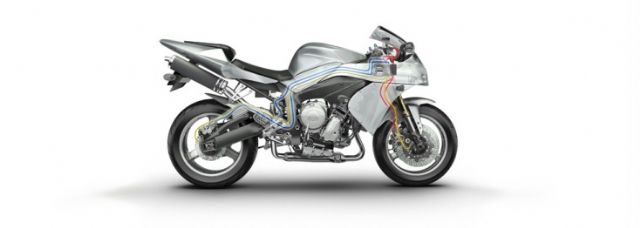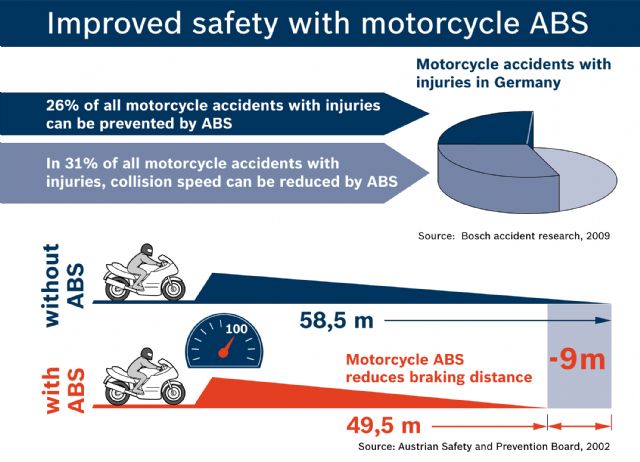ABS Required on New PTWs Sold in Taiwan from 2019
2015/07/01 | By Quincy LiangThe Taiwanese government's recent announcement to require all new motorcycles and scooters produced sold on the island from 2019 to be equipped with either an anti-lock brake system (ABS) or combined brake system (CBS) is expected to raise a tsunami in Taiwan's powered two-wheeler (PTW) industry, some industry experts forecast.

The Ministry of Transportation and Communications (MOTC) recently introduced rules requiring all new PTWs sold in Taiwan to be have ABS (on models with engine displacements over 125cc), or CBS (also called a linked braking system, or LBS, for under 124cc models). The new regulation is expected to reduce injuries from PTW accidents but will increase the production costs and retail prices of PTWs, potentially causing headwinds for new-PTW sales.
A local PTW vendor estimates ABS costs at between NT$12,000 and NT$20,000 (US$400 and US$667) and CBS costs at about NT$3,000 (US$100). With the ABS, the end price for a medium- to high-level 125cc gasoline scooter is expected to outstrip NT$100,000 (US$3,333), dampening mainstream demand for quite some time.
Some local PTW vendors have complained that the government's ABS/CBS rule follows similar regulations in some European nations. However, while ABS may be needed on PTWs in European riding environments, they may not be necessary in Taiwan. The new regulation will reduce demand for new PTWs as most buyers are in a relatively lower-income group. The vendors warned that the industry could the victim.
In Taiwan, the greatest majority of PTWs (and especially scooters) are used for short-distance commuting, the vendor said, so the new-PTW sales concentrate mainly in the under-150cc segment. There is already a speed limit for the under-150cc PTWs, they explained, and the ABS maybe a bit excessive, because in the greatest majority of cases, the vehicle is stopped before the ABS is activated.
A previous case quoted by local PTW vendors to describe the possible heavy impact on local PTW industry is the increasingly stringent emission standard. Taiwan put the fifth-stage emission standard into effect in 2009, requiring all PTWs sold on the island to be with the electronic fuel-injection (EFI) system. The compulsory standard ramped up the end prices of a general 125cc scooter from about NT$50,000 (US$1,667) to higher than NT$70,000 (US$2,333), scared away many new-PTW buyers. The result was: in 2009, sales of new PTWs in Taiwan suddenly plunged from about 800,000 units in 2008, to only about 500,000, and the impact was even heavier on locally produced models. Such phenomenon was called as the first tsunami on local PTW industry by vendors, most of whom suffered losses in 2009.
Domestic PTW sales, then, began gradually recovering from the bottom in the following years of 2009, to about 541,000 units in 2010, 606,000 in 2012, and 674,000 in 2014, as consumers began adapting to the higher price tags. However, industry experts' forecast that the new rules might drive domestic new-PTW sales down to a new low of about 400,000 units a year, which could "suffocate" the over industry again.

Industry sources point out that Bosch of Germany started to develop motorcycle ABS at the end of the 1980s, basing it on a system designed for passenger cars. The first systems finally rolled off the production line in 1994. They were installed in Suzuki police bikes in Japan. In the following years, volumes grew only slowly. This changed in 2009. First of all, interest in safety technology picked up and, second, Bosch launched its new flagship Generation 9. For the first time, this was a solution that was not derived from passenger-car technology, but instead developed specifically for use in motorcycles. The result was high performance at half the size and weight of the predecessor generation. Demand exceeded all expectations. As a result, production has risen by an annual average of more than 50% since 2009. In 2013 alone, roughly 350,000 systems have been manufactured. Now, every fourth motorcycle made in Europe has ABS on board. Bosch says that there is currently no sign that this dynamic growth will end.

